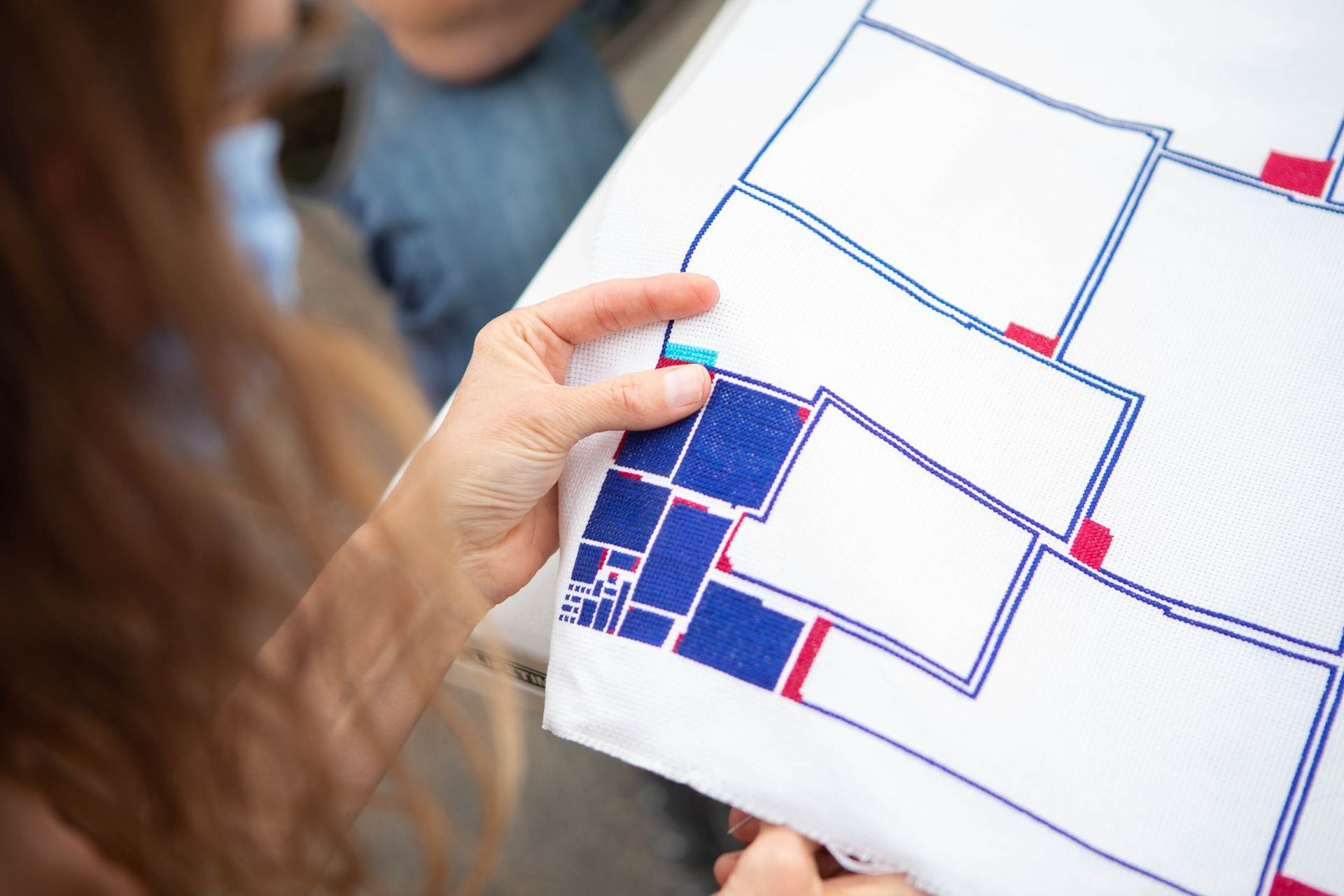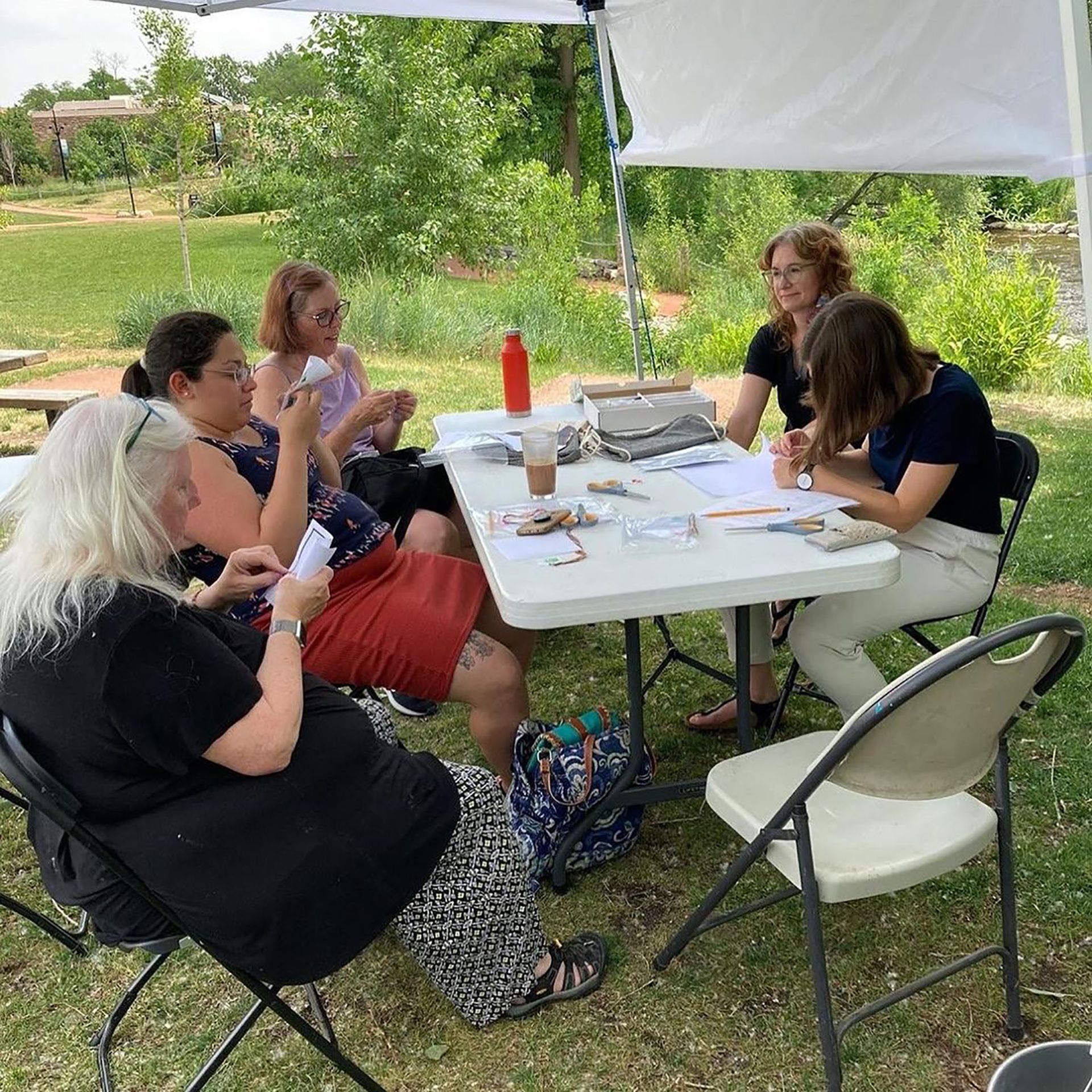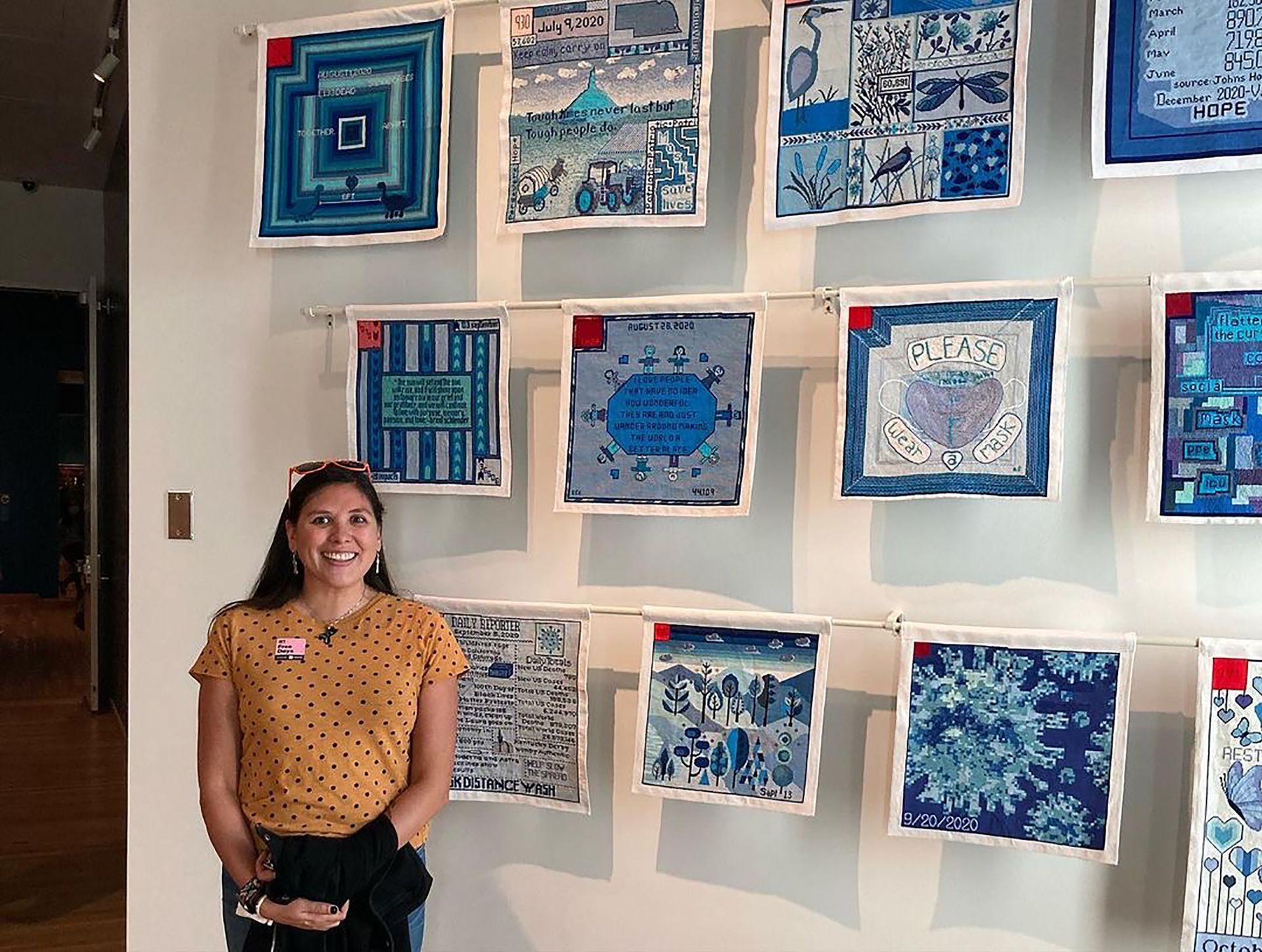STITCHING THE SITUATION
DENVER, CO
WE-Making is a suite of resources that explores the relationship between place-based arts practices and social cohesion as a means to advance health equity and community wellbeing. This We-Making story is one example of how place-based arts and cultural strategies uniquely contributed to social cohesion and wellbeing in this community. Throughout this story you’ll see terms paired with actions in parentheses (e.g., social capital, collective action, place attachment, civic engagement, self-determination of shared values). This is to denote for the reader how the WE-Making framework was specifically incorporated. Explore the WE-Making framework and resources.
Image credit: Stitching the Situation
It’s the summer of 2023, and you are walking downtown, passing the capitol building on your way to the park for a walk. You notice a group of people seated around a table, and rows of what look like flags or banners swaying in the breeze. Upon closer inspection, you realize the banners are pieces of embroidered cloth—some with lists of names, some with images of masks, others with inspirational quotes, stories, or images of animals and plants—covered in blue and red stitches, each marked with a date: June 26, 2020…Aug 31, 2020… They range in size, some as small as a dinner plate, others almost small tablecloths—and still, the stitches cover the surface. As you approach the tables, you see people stitching on larger pieces of cloth, and someone is sharing a story about their mother (or sister, daughter, friend) who died from COVID in 2021. She was a nurse. Another person answers them with a story about their friend (or child, sibling, co-worker), who was her patient, survived, and now suffers from long COVID. A woman in a smart suit listens intently, taking notes, while others quietly add stitches to the tapestry. You realize the woman is the governor, and ask someone nearby what is going on.
They tell you this is an event held by a coalition formed during the COVID-19 crisis, and the stitching is a visualization of the people who had COVID, and those who died. The people stitching are community members—the bereaved, folks with Long COVID, leaders of local aid organizations, policy makers and government officials—who came here to stitch this tapestry, listen to each others’ experiences and discuss how, in the wake of the pandemic, they can work together to heal and better meet the needs of the community (social capital- bridging; mindset- orientation toward the common good). The tapestry, you learn, is a memorial and record of the pandemic, created by hundreds of people across the country. You are invited to join them, and through the work of your hands, add your story to the cloth. A volunteer shows you how to thread a needle. You select a piece of thread the color of the sky, then you sit, and make an “X” for your neighbor, who worked at the local factory and got sick. Then one for your mom, who taught elementary school and was forced to retire when your dad (another stitch) caught COVID, and the symptoms lingered for months.

This is a future vision of where Stitching the Situation is headed. It is already well underway, with over 200 people around the country stitching, local community stitching sessions that started in the summer of 2020, and an exhibition of 12 completed blocks on display at the Denver Art Museum. The current fluctuating circumstances—whether COVID-19 levels or political/social/economic turmoil— have us all in various states of hope, concern, distress, anxiety, denial, impatience, etc., sometimes all in one minute. This project offers a calming space to hold these feelings and stories together, tension and all, while we walk into the unknown future (mental health- social capital and social support).
“I started this project having never cross stitched a day in my life. I’ve always been known for my doodling, but in recent months my chronic illness led to loss of feeling in my thumb if I doodled too much. Art has always been an anxiety reliever for me... This project saw me through a lot. I stitched through weeks of the worst anxiety I’ve had for years—through loneliness, friends’ diagnoses, my grandparents’ vaccines, the new hope blooming through our country and world.”
—Katie, stitching collaborator.
In March of 2020, as COVID numbers climbed, I was drawn to a simple, ancient creative form: the humble stitch. I grasped for connection through the fabric’s threads, weaving stitches through its surface, as a physical proxy for the human touch and physical spaces we relinquished during lockdown. The slow, methodical stitching tempered anxiety, offering a way to mark these lives (one blue cross stitch per positive case and one red stitch per death reported) and passage of time, providing calming space to be present amidst the chaos.
That May, I invited my neighbors to stitch with me, as the fabric panel was long enough to allow for social distancing. Together, we marked the lives directly affected by the virus, and considered how our families (street, neighborhood, city, etc.) were experiencing this time. These stitching sessions provided connection during an isolating time, space to share our personal needs and offer support. I lost my uncle to COVID mere weeks before, and could not be with my family to mourn his passing. Having my neighbors gather with me has been essential to my own grief process (social capital- bonding).

“I experienced firsthand the power of working on a collaborative art project with others. I realized how valuable this experience was for sharing what it feels like to live and grieve during the COVID-19 pandemic. People turn to the arts in challenging times, because the arts help us heal, share stories, make meaning, and drive collective action and social change. It is vital that everyone in our Boulder community has the opportunity to access this type of work as we move between COVID-19 relief and recovery.” —Ellen Teig, neighbor, public health consultant and Boulder Food Rescue board member.
Since that summer, stitching sessions have been occurring in various locations throughout our city, in local museums and galleries, public parks, and libraries. These in-person sessions serve as community-building opportunities in the midst of this crisis, as we grapple with how to be together safely and support ALL people in our community (collective action- community participation facilitating dialogue to lead to deeper engagement). We are working with local housing and food access organizations (Boulder Housing Partners and Boulder Food Rescue), as a means to record the experiences of those they serve—centering the voices of our most heavily impacted neighbors—and hold community engagement events that share these stories and highlight opportunities to support current local needs (self determination of shared values- connecting people across differences, discussing issues, forming connections). As part of this process, we work with a local translator to ensure all materials are available in Spanish (civic engagement- high opportunity, low barrier). With this, we are beginning reach out to additional Hispanic/Latine communities, including undocumented neighbors who have limited access to services. We also work with our local public library to hold stitching sessions and workshops; together we distributed 200 small kits that will result in a quilt-like public installation next year.
In June 2020, we started making individual kits that represent one day’s data. Currently, there are about 200 “blocks” that have been distributed across the US. These kits are funded by grants and individual donations, sent at no charge directly to participants, with detailed instructions and how-to videos (with CC and Spanish subtitles) available on the project website. Additional thread or materials are available as need arises. Cross stitching is a simple form of embroidery, and while the color scheme is blue and red, any hue or value may be used to create complex designs. These designs reflect individual experiences of this time, and add another layer of stories to the lives the individual stitches represent. We are working on additional accessibility for those who are unable to stitch, whether due to time constraints, physical limitations, or other factors to ensure their stories are able to be included.
“This block is my version of a newspaper that reports not only the Covid numbers, but also some other things that happened on September 5th. …the lock down and the social isolation of the pandemic prevented me from saying goodbye in person to my mother before her passing, and it adversely affected my husband's dementia and contributed to his passing. Creating this piece of art is in memory of them even though they didn't die of Covid, and for all those who died of the virus.” —Bev, stitching collaborator.

Participant-led processes and growth have driven the development of this project (collective efficacy- community ownership to achieve collective action). From responding to personal experience, to collaborating with my neighbors and local community, and now extending to a wider online collective, we work with each participant to support their abilities, and meet any additional needs or connect them with resources. We partner with organizations to center each community’s abilities. We are working diligently to ensure accessibility to people who are often excluded from art spaces, and publicly recorded history. Right now that includes populations living in low-income housing, elderly and disabled residential centers, and those receiving food assistance. We are in conversations with organizations serving prison and formerly incarcerated populations, undocumented Americans, and indigenous communities (civic capacity for structural change- creating platforms for continued organizing among socially excluded groups).
Stitching the Situation is a responsive project, participant-shaped process, and dynamic collaborative work of art. It is open to all, open-ended, and constantly expanding its reach and purpose as more join in. What started as a physical record became a tribute to those no longer with us and those left behind; a meditative space for contemplation opened into a complex narrative of experiences; a record of how systemic inequity shapes our present birthed a space to imagine, plan and execute new possibilities.



